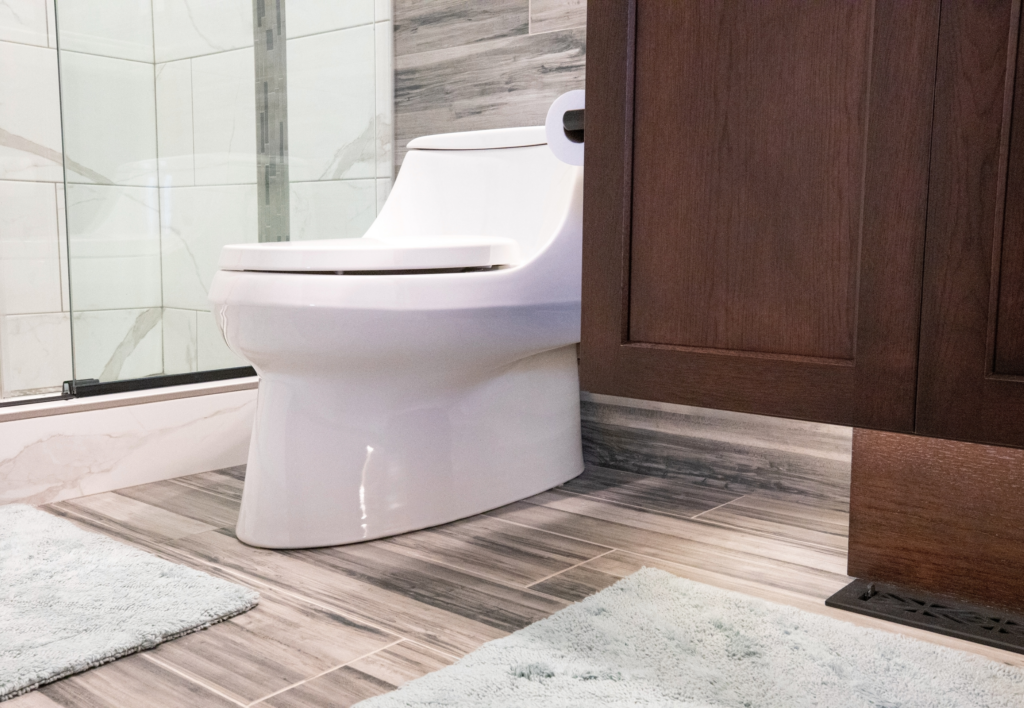Skirted vs Non-Skirted Toilet: Comparing Designs for Your Bathroom
When selecting a toilet, homeowners are often presented with a choice between skirted and non-skirted designs. I’ve found that a skirted toilet, which features a smooth base that conceals the trapway, offers a cleaner and more streamlined appearance. The absence of crevices around the base makes it notably easier to maintain hygiene since it reduces the spots where dust and grime can collect.
On the other hand, non-skirted toilets, with their exposed trapways, have a more traditional look and may fit a variety of bathroom styles. While they may require more effort to clean due to the visible bends and piping, these toilets are often less expensive and can be simpler to install. Each type has distinct advantages, prompting a careful consideration based on individual preferences and the specific layout of one’s bathroom.
Design and Aesthetics
In my professional experience, when considering a toilet’s design, two distinct styles stand out: the modern skirted toilet with its sleek profile and the traditional non-skirted with its classic lines.
Skirted Toilet Design
Skirted toilets feature a smooth surface and clean lines, offering a minimalist design that blends seamlessly with modern bathroom decor. The skirt, which conceals the trapway, creates a uniform look that I find particularly appealing.
This type of design not only contributes to the bathroom’s aesthetic but also facilitates easier cleaning due to the lack of crevices where dust and grime typically accumulate.
Traditional Non-Skirted Toilets
On the other hand, traditional non-skirted toilets present a more conventional appearance. The exposed trapway is a characteristic design feature that, while not as streamlined as the skirted variant, highlights the classic toilet silhouette.
For those who prefer a time-honored aesthetic or wish to maintain the historical integrity of their bathroom, non-skirted toilets remain a fitting choice. Despite their traditional look, they can still complement a variety of bathroom styles.
Installation and Maintenance
When it comes to incorporating a new toilet into your bathroom, understanding the nuances of installation and maintenance can save you time and effort. Skirted toilets present unique challenges during installation, while non-skirted toilets offer ease in upkeep.
Installing Skirted Toilets
In my experience, installing skirted toilets can be more complex than their non-skirted counterparts. The sleek design hides the trapway and the bolts, called johnny bolts, which connect the toilet to the floor flange, making access more difficult. Here’s a step-by-step guide to simplify the process:
- Position the Toilet: Carefully place the toilet over the floor flange. Ensure it’s aligned properly.
- Secure the Bolts: Tighten the johnny bolts through the access points on the skirted design—this secures the toilet to the floor flange.
- Test for Stability: Gently check the toilet for any movement to ensure a secure fit.

Maintaining Non-Skirted Toilets
When it comes to maintenance, I’ve found non-skirted toilets to be easier to manage due to their exposed trapway. Here’s how to keep them clean:
- Regular Cleaning: Use a standard bathroom cleaner and a brush to scrub the exposed trapway.
- Check the Bolts: Regularly inspect the johnny bolts for signs of corrosion or looseness to prevent leaks.
By adhering to these guidelines, you’ll ensure that your skirted or non-skirted toilet remains a reliable and hygienic part of your bathroom.
Cost Considerations
When considering a new toilet, cost is a pivotal factor for most homeowners. I’ve gathered specific pricing details to guide you through the financial aspect of choosing between skirted and non-skirted toilets.
Pricing of Skirted Toilets
In my experience, skirted toilets tend to be more expensive due to their modern design and the added complexity of their hidden trapways. Prices typically start from around $250 and can go as high as $600 or more, depending largely on the brand and features.
Pricing of Non-Skirted Toilets
Non-skirted toilets are generally more affordable and are an excellent choice for budget-conscious consumers. You can find quality options starting at around $100, with higher-end models reaching approximately $350. The traditional design and easier installation help keep costs down for this style.
Functionality and Performance

In my extensive experience with bathroom renovations and fixtures, functionality and performance are pivotal factors in choosing between skirted and non-skirted toilets.
Efficiency of Skirted Toilets
Skirted toilets showcase a concealed trapway, offering a sleek design and facilitating easier cleaning. I’ve found that most skirted models maintain water efficiency effectively, often using no more than 1.28 gallons per flush, in accordance with the EPA’s WaterSense standards.
In some cases, these toilets are equipped with dual-flush mechanisms, further conserving water. However, one must note that while the concealed trapway enhances aesthetics and cleanliness, it does not inherently impact the flushing power or water efficiency of the toilet.
- Water Efficiency:
- High-efficiency toilets (HET): 1.28 gallons per flush or less
- Dual-flush option: Reduced water for liquid waste
Performance of Non-Skirted Toilets
On the other hand, I’ve observed that non-skirted toilets, which display an exposed trapway, offer a straightforward approach to maintenance and repair, which might appeal to those who prioritize practicality over form.
Some models of non-skirted toilets feature pressure-assisted flushing systems, which can be more reliable in clearing the bowl. It is important to mention, however, that greater flushing power may come at the cost of increased water usage and noise.
- Flushing Systems:
- Gravity-fed: Common, reliable
- Pressure-assisted: Higher performance, but possibly louder and less water-efficient
Let Us Know How We’re Doing!
Did this expertly prepared resource answer your question?
Do you have another question about home maintenance, home improvement projects, home appliance repair, or something else?
Get more information, send in questions and keep the discussion going by contacting the I’ll Just Fix It Myself company customer service team at at 1-800-928-1490 or Email us at [email protected]
